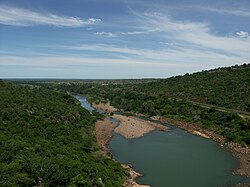| Pongola River uPhongolo | |
|---|---|
 Pongola river, immediately below Pongolapoort Dam | |
| Etymology | From the Zulu for 'trough-like', 'river of troughs', referring to long pools. [1] |
| Location | |
| Country | South Africa, Mozambique |
| Physical characteristics | |
| Source | |
| • location | Near Utrecht, KwaZulu-Natal, South Africa |
| Mouth | Maputo River |
• location | Maputo Province, Mozambique |
• coordinates | 26°51′21″S32°20′47″E / 26.85583°S 32.34639°E |
• elevation | 29 m (95 ft) |
The Phongolo River is a river in South Africa. It is a tributary of the Maputo River. It rises near Utrecht in northern KwaZulu-Natal, flows east through oPhongolo, is dammed at Pongolapoort, and crosses the Ubombo Mountains; then it flows north towards Mozambique, joining the Maputo River. [2]
Its main tributaries are the Bivane River and the Mozana River in South Africa, as well as the Ngwavuma in Eswatini. [3]
The name of the uPhongolo River is derived from the isiZulu word for a barrel, vat, trough, or cask, referring to the deep and sometimes long pools that are found in this river. [4] [5]

